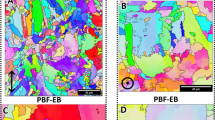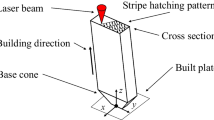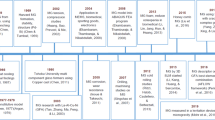Abstract
Digital light processing (DLP) technology has presented great potential to fabricate ceramic structures including alumina component, yet the mechanical properties of DLP-manufactured ceramics are still difficult to be guaranteed. The enhancement of mechanical properties of DLP-fabricated ceramic materials is challenging and imperative in the field of industrial application. This paper investigates the printing and heat treatment processes of additively manufactured ceramic to achieve defect-free Al2O3 ceramic with high performance. Firstly, Al2O3 ceramic slurry with a high solid content of 55 vol.% and viscosity of 6.04 Pa·s (at the shear rate of 100 s−1) is prepared. Then, Al2O3 ceramic is manufactured with digital light processing, debinding and sintering processes sequentially. Thirdly, the effects of sintering temperatures on the shrinkage, density, microstructure, and mechanical properties of the Al2O3 ceramics are analyzed. The shrinkage, density, and flexural strength of the sintered ceramic increase with temperature; the microhardness shows a non-monotonic trend with the increase of sintering temperature. Finally, the influence mechanism of sintering temperature on microstructures and mechanical properties of the DLP-fabricated ceramics is interpreted and discussed. The ceramic grains grow and combine to form long columnar grains during higher sintering temperatures. The density, microhardness and flexural strength of the Al2O3 ceramics sintered at 1600 °C are achieved 3.51 g/cm3, 17.71 GPa and 175.8 MPa, respectively.









Similar content being viewed by others
Data availability
The processed data required to reproduce these findings cannot be shared at this time as the data also forms part of an ongoing study.
References
Pelz JS, Ku N, Meyers MA, Vargas-Gonzalez LR. Additive manufacturing of structural ceramics: a historical perspective. J Mater Res Technol. 2021;15:670–95. https://doi.org/10.1016/j.jmrt.2021.07.155.
Shahzad A, Lazoglu I. Direct ink writing (DIW) of structural and functional ceramics: recent achievements and future challenges. Compos Part B Eng. 2021;225:109249. https://doi.org/10.1016/j.compositesb.2021.109249.
Sachsc E, Cima M, Williams P, Brancazio D, Cornie J. Three dimensional printing: rapid tooling and prototypes directly from a CAD model. J Manuf Sci Eng Trans. 1992;114:481–8. https://doi.org/10.1115/1.2900701.
Delissen A, Boots E, Laro D, Kleijnen H, van Keulen F, Langelaar M. Realization and assessment of metal additive manufacturing and topology optimization for high-precision motion systems. Addit Manuf. 2022;58:103012. https://doi.org/10.1016/j.addma.2022.103012.
Gonzalez JA, Mireles J, Lin Y, Wicker RB. Characterization of ceramic components fabricated using binder jetting additive manufacturing technology. Ceram Int. 2016;42:10559–64. https://doi.org/10.1016/j.ceramint.2016.03.079.
Huang Y, Wu D, Zhao D, Niu F, Ma G. Investigation of melt-growth alumina/aluminum titanate composite ceramics prepared by directed energy deposition. Int J Extrem Manuf. 2021;3:035101. https://doi.org/10.1088/2631-7990/abf71a.
Hadian A, Koch L, Koberg P, Sarraf F, Liersch A, Sebastian T, Clemens F. Material extrusion based additive manufacturing of large zirconia structures using filaments with ethylene vinyl acetate based binder composition. Addit Manuf. 2021;47:102227. https://doi.org/10.1016/j.addma.2021.102227.
Pfeiffer S, Florio K, Makowska M, Marone F, Yüzbasi S, Aneziris CG, Swygenhoven HV, Wegener K, Graule T. Crack-reduced alumina/aluminum titanate composites additive manufactured by laser powder bed fusion of black TiO2−x doped alumina granules. J Eur Ceram Soc. 2022;42:3515–29. https://doi.org/10.1016/j.jeurceramsoc.2022.02.046.
Windsheimer H, Travitzky N, Hofenauer A, Greil P. Laminated object manufacturing of preceramic-paper-derived Si-SiC composites. Adv Mater. 2007;19:4515–9. https://doi.org/10.1002/adma.200700789.
Griffith ML, Halloran JW. Freeform fabrication of ceramics via stereolithography. J Am Ceram Soc. 1996;79:2601–8. https://doi.org/10.1111/j.1151-2916.1996.tb09022.x.
Rasaki SA, Xiong D, Xiong S, Su F, Idrees M, Chen Z. Photopolymerization-based additive manufacturing of ceramics: a systematic review. J Adv Ceram. 2021;10:442–71. https://doi.org/10.1007/s40145-021-0468-z.
Song X, Chen Y, Lee TW, Wu S, Cheng L. Ceramic fabrication using mask-image-projection-based stereolithography integrated with tape-casting. J Manuf Process. 2015;20:456–64. https://doi.org/10.1016/j.jmapro.2015.06.022.
Lakhdar Y, Tuck C, Binner J, Terry A, Goodridge R. Additive manufacturing of advanced ceramic materials. Prog Mater Sci. 2021;116:100736. https://doi.org/10.1016/j.pmatsci.2020.100736.
de Camargo IL, Morais MM, Fortulan CA, Branciforti MC. A review on the rheological behavior and formulations of ceramic suspensions for vat photopolymerization. Ceram Int. 2021;47:11906–21. https://doi.org/10.1016/j.ceramint.2021.01.031.
Zhang L, Huang J, Xiao Z, He Y, Liu K, He B, et al. Effects of debinding condition on microstructure and densification of alumina ceramics shaped with photopolymerization-based additive manufacturing technology. Ceram Int. 2022;48:14026–38. https://doi.org/10.1016/j.ceramint.2022.01.288.
Zhang H, Yang Y, Hu K, Liu B, Liu M, Huang Z. Stereolithography-based additive manufacturing of lightweight and high-strength Cf/SiC ceramics. Addit Manuf. 2020;34:101199. https://doi.org/10.1016/j.addma.2020.101199.
Li H, Liu Y, Liu Y, Zeng Q, Wang J, Hu K, et al. Evolution of the microstructure and mechanical properties of stereolithography formed alumina cores sintered in vacuum. J Eur Ceram Soc. 2020;40:4825–36. https://doi.org/10.1016/j.jeurceramsoc.2019.11.047.
Wu Z, Liu W, Wu H, Huang R, He R, Jiang Q, et al. Research into the mechanical properties, sintering mechanism and microstructure evolution of Al2O3-ZrO2 composites fabricated by a stereolithography-based 3D printing method. Mater Chem Phys. 2018;207:1–10. https://doi.org/10.1016/j.matchemphys.2017.12.021.
Chen S, Wang CS, Zheng W, Wu JM, Yan CZ, Shi YS. Effects of particle size distribution and sintering temperature on properties of alumina mold material prepared by stereolithography. Ceram Int. 2022;48:6069–77. https://doi.org/10.1016/j.ceramint.2021.11.145.
Zhang K, He R, Ding G, Bai X, Fang D. Effects of fine grains and sintering additives on stereolithography additive manufactured Al2O3 ceramic. Ceram Int. 2021;47:2303–10. https://doi.org/10.1016/j.ceramint.2020.09.071.
Varghese G, Moral M, Castro-García M, López-López JJ, Marín-Rueda JR, Yagüe-Alcaraz V, et al. Fabricación y caracterización de cerámicas medinate impresión 3D DLP de bajo coste. Bol La Soc Esp Ceram y Vidr. 2018;57:9–18. https://doi.org/10.1016/j.bsecv.2017.09.004.
Gentry SP, Halloran JW. Absorption effects in photopolymerized ceramic suspensions. J Eur Ceram Soc. 2013;33:1989–94. https://doi.org/10.1016/j.jeurceramsoc.2013.03.004.
Zhou M, Liu W, Wu H, Song X, Chen Y, Cheng L, et al. Preparation of a defect-free alumina cutting tool via additive manufacturing based on stereolithography—optimization of the drying and debinding processes. Ceram Int. 2016;42:11598–602. https://doi.org/10.1016/j.ceramint.2016.04.050.
Coppola B, Lacondemine T, Tardivat C, Montanaro L, Palmero P. Designing alumina-zirconia composites by DLP-based stereolithography: microstructural tailoring and mechanical performances. Ceram Int. 2021;47:13457–68. https://doi.org/10.1016/j.ceramint.2021.01.204.
Wang CJ, Huang CY. Effect of TiO2 addition on the sintering behavior, hardness and fracture toughness of an ultrafine alumina. Mater Sci Eng A. 2008;492:306–10. https://doi.org/10.1016/j.msea.2008.04.048.
Calambás Pulgarin HL, Albano MP. Sintering, microstrusture and hardness of different alumina-zirconia composites. Ceram Int. 2014;40:5289–98. https://doi.org/10.1016/j.ceramint.2013.10.102.
Roh JY, Kwon J, Lee CS, Choi JS. Novel fabrication of pressure-less sintering of translucent powder injection molded (PIM) alumina blocks. Ceram Int. 2011;37:321–6. https://doi.org/10.1016/j.ceramint.2010.09.011.
Li H, Liu Y, Liu Y, Hu K, Lu Z, Liang J. Influence of sintering temperature on microstructure and mechanical properties of Al2O3 ceramic via 3D stereolithography. Acta Metall Sin. 2020;33:204–14. https://doi.org/10.1007/s40195-019-00950-y.
Rice RW, Wu CC, Boichelt F. Hardness–grain-size relations in ceramics. J Am Ceram Soc. 1994;77:2539–53. https://doi.org/10.1111/j.1151-2916.1994.tb04641.x.
Acknowledgements
The authors would like to acknowledge the National Key Research and Development Program of China (2019YFB2005401) and the financial support from the National Natural Science Foundation of China (91860207). This work was also supported by grants from Taishan Scholar Foundation and Shandong Provincial Key Research and Development Program (Major Scientific and Technological Innovation Project 2020CXGC010204). Shandong Provincial Science Foundation for Excellent Young Scholars (2022HWYQ-059), Fundamental Research Funds for the Central Universities (2021JCG009).
Author information
Authors and Affiliations
Corresponding author
Ethics declarations
Conflict of interest
The authors declare that they have no known competing financial interests or personal relationships that could have appeared to influence the work reported in this paper.
Ethical approval
This article does not contain any studies with human participants or animals performed by any of the authors.
Additional information
Publisher's Note
Springer Nature remains neutral with regard to jurisdictional claims in published maps and institutional affiliations.
Rights and permissions
Springer Nature or its licensor (e.g. a society or other partner) holds exclusive rights to this article under a publishing agreement with the author(s) or other rightsholder(s); author self-archiving of the accepted manuscript version of this article is solely governed by the terms of such publishing agreement and applicable law.
About this article
Cite this article
Xin, M., Liu, Z., Wang, B. et al. Microstructures and mechanical properties of additively manufactured alumina ceramics with digital light processing. Archiv.Civ.Mech.Eng 23, 52 (2023). https://doi.org/10.1007/s43452-022-00588-1
Received:
Revised:
Accepted:
Published:
DOI: https://doi.org/10.1007/s43452-022-00588-1




